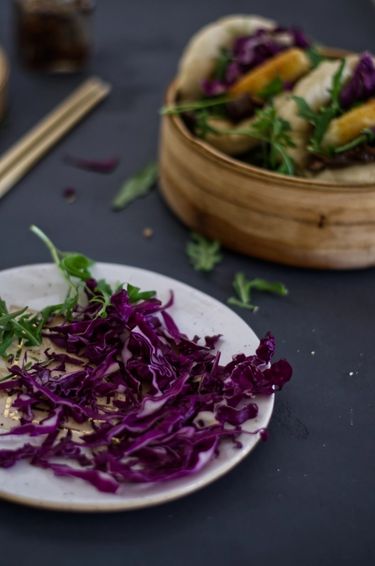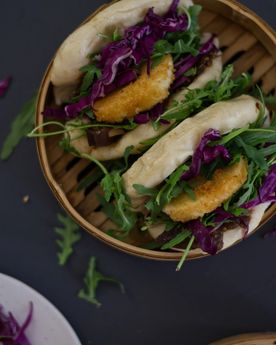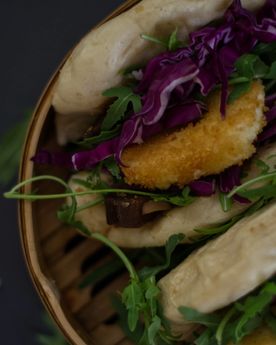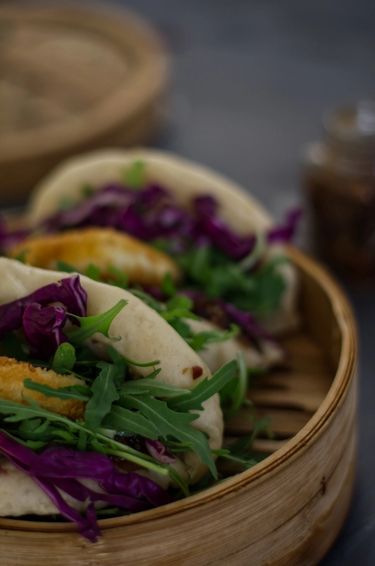If you enjoy this article, or any other content from this website, please subscribe to the newsletter. Your support can make a big difference!
It's mid-September and I'm halfway between ready for Autumn. On the one hand, I'm super excited to be experiencing this wonderful season in Italy; on the other, I'm excited to be getting the most I can out of the Maltese summer before it gets colder than I want to imagine.
Sometimes, I see cold weather as a necessary evil. It gives me more space to focus, with less glorious weather to distract me. Instead, I'd want to be all cosied up inside, working on my cooking skills.
Colder weather is also about comfort food. And one of my favourites from the beautiful region of Asia, where I spent the last couple of years, is gua bao.
What are bao buns (gua bao)?
Think fluffy, cushiony white buns that are steamed to perfection. As the buns are sliced before steaming, they typically sandwich stewed meat like pork belly but this is not to say you can't fill it with your heart's desire.

Origin of bao buns
Bao buns (also known as gua bao) are a popular street food in Taiwan and North China but have become popularised in the West. The very name 'bao buns' is erroneous, as bao actually means bun.
Today, bao buns have become available to many hungry-goers in the West, with an exploding demand seen in metropolia like London and New York. New trendy "gua bao" which incorporate pan-Asian fusion or non-Chinese stuffings, such as kimchi (Korean fermented vegetables) or karaage (Japanese fried chicken) are becoming increasingly popular.
What are steamed bao buns made of?
These soft and fluffy steamed buns are incredibly delicious and not too complex to make — although the process takes some time (as with most doughs). All you need are a few simple ingredients and the sky's the limit for your choice of filling.
The dough is traditionally made with both warm water and warm milk — which makes the buns softer. Sugar is also added to the mix, as Asian doughs tend to be on the sweeter side. For the dough's rise, you could use baking power whilst others recommend using active dried yeast as well.
In essence, the simplest way to make a bun would be:
- Warm water
- All-purpose flour (use blenched flour if you want complete white buns)
- Salt
- Sugar
Other ingredients used in traditional recipes include:
- Warm milk
- Active dried yeast
- Vegetable or seed oil
I'm Vegan. Can I make vegan bao buns?
Yes! You can certainly omit milk from the dough and stick to water. You can also add whatever fillings you like. As a recommendation, I would add ingredients that have a bit of a crunch, like pickled vegetables (kimchi, sauerkraut, Vietnamese coleslaw) or fresh lettuce, carrot ribbons, shredded cabbage, grilled or deep-fried vegetables (or tofu/seitan). Don't forget to add sauce to bring all the ingredients together.
Can I make wholewheat bao?
Yes! You can use wholemeal (wholewheat) bread flour but I wouldn’t recommend doing 50% or 100% wholemeal flour as it’ll make the buns too dense and they won’t be as fluffy.
What do you eat with steamed buns?
Usually, steamed buns are filled to the brim. Three of these buns tend to be enough as a main but you can have them with a side of salad.
In this recipe, I fill my bao buns with Maltese goat cheese called gbejna. This cheese is used in many local dishes, one of which is the infamous Maltese tuna sandwich which you can read about here . This cheese comes fresh or dried. For the purpose of this recipe, I use fresh goat cheese and fry it in breadcrumbs. It's absolutely divine.
For the sauce, I use my homemade aubergine chutney which pairs perfectly with the fried goat cheese. The chutney requires a couple of hours to make, so it can be made whilst the dough is being prepared. However, if you are not up for making the chutney, any other chutney would work.
I also add rocket for some bitterness, to counteract the sweetness of the chutney and cabbage for some crunch as the buns are soft and so is the fried cheese.


How do you steam bao buns?
I have a Chinese bamboo steamer, which is stackable with additional layers. You can get them online or from your local Asian food shop. If you don’t have a bamboo steamer you can use a metal one. If you don’t have a steamer you can hack one by placing a large metal colander into a large pot with a bit of water at the bottom of the pot, then cover with a large pot lid.
Steaming the bao buns is simple.
- Place the steamer into a wide saucepan or pot that it can fit snugly in.
- Pour water into the pan — I usually keep it at about 2cm deep. You can top up the water as needed while steaming, so it doesn’t run dry. The most important thing is that the water level doesn’t rise above the base of the steamer as you don’t want the water to come into direct contact with whatever is in the steamer.
- Bring the water to a boil over medium heat, place baking parchment on the surface of the steamer so the buns don't stick then fill the steamer with your buns (they expand quite a bit when steaming so leave some room around them)
- Cover the steam with the lid. Place into the pan of water and turn the heat down so the water is simmering. Let the buns steam for 5-6 minutes — it is important not to remove the lid during this time as the trapped steam inside is cooking the buns!

How do you keep steamed buns warm?
Keep them in the bamboo steamer with the lid closed. They should stay warm like this for ~10 minutes. You can cook all the bao ahead of time and then reheat a couple at a time by steaming for 1-2 minutes before eating. That way you always have hot ones to eat.
Why are my bao buns not white?
Regular flour (unbleached flour) gives the dough yellowish ting. The addition of baking powder/bicarbonate of soda can also cause a yellowing of the dough after steaming. You may notice that if you don’t knead the baking powder into the dough thoroughly, there will be little yellow spots on the buns (this is just an aesthetic issue, they’ll still taste fine). You can buy bleached white flour from some Chinese supermarkets if you’re really after that snowy white look.
Where can I buy bao buns?
Check out your local Asian store to find out if they stock frozen bao buns.
Can you freeze bao buns and can you reheat frozen ones?
Absolutely. To do this, steam all of the bao as instructed. Let the bao buns cool completely then carefully place them into a resealable bag or large enough container that won't squash them. Label and date them for future reference! You can reheat the bao straight from frozen, just pop a few into your steamer and steam for 5-8 minutes until hot in the middle. Best to eat them after 3 months.

Fluffy Steamed Buns with Fried Goat Cheese and Chutney
2 reviews
Description
A delicious Mediterranean twist on the Asian Steamed Bao Bun
Information
- Servings
- 15buns
- Preparation time
- 150minutes
- Cooking time
- 60minutes
Ingredients
- 80mlwarm water
- 120mlmilk
- 9.5grActive yeast
- 50grSugar
- 40mlVegetable oil
- 345grAll purpose flour (reserve 30g four coating the goats cheese)
- 1.2grBaking powder (1/2 tsp)
- 1.5grSalt (1/4 tsp) (and additional salt for the breadcrumb mix)
- 50grRocket
- 300grGoat cheese
- 2Egg, whisked
- 50grFine breadcrumbs
- 50grAubergine chutney (recipe available on the blog)
- 25grPurple cabbage, sliced thinly
Method
1. Prepare the dough
Combine warm water, milk, active yeast, sugar and oil. Whisk to let yeast and sugar to dissolve then let it sit until years activate, about 5 to 10 minutes.
Meanwhile combine flour, sugar, baking powder and salt in a stand mixer. You can knead the dought with your hands too, if you prefer.
Pour the wet ingredients into the bowl with dry ingredients. Start on a low speed to slowly incorporate all the ingredients together, then on medium speed until it becomes doughy. Keep kneading for 3 to 4 minutes on medium speed. The dough should be elastic and really soft but not stick to your fingers or the mixing bowl.
Take the dough out from the hook and form it into a ball. Place it back into the mixing bowl, cover with a damp cloth and let it rise in a warm place until it becomes triple in size, about 2 hours. Let it sit longer if needed.
2. Prepare the filling
I use Maltese goat cheese for this recipe but any soft goat cheese is fine. Slice up fresh goat cheese into 1cm thick pieces. Prepare a plate with flour, another with whisked egg and another with fine dried breadcrumbs. Add a pinch of salt to each plate and mix. Once done, gently coat the slices of goat cheese in flour, then dip these in egg, followed by dried breadcrumbs.
Prepare a pot with vegetable oil and bring to a boil. Monitor the temperature with a cooking thermometer, if possible, as this will tell you when the oil is ready for frying.
When the oil is hot enough, carefully drop the breaded cheeselets and cook until golden. Place the fried cheeselets on a plate lined with a paper towel, to absorb the oil.
For the sauce, I use my homemade aubergine chutney, which pairs perfectly with the deep-fried goat cheese. Check out my blog post to get the recipe. Otherwise, you are free to use whatever chutney you have at home.
3. Prepare the buns
Place the raised dough on a working surface. Roll out the dough to 0.5cm thick. Cut the dough into a 9cm wide circle with a ring mould or glass (I used a wine glass). This recipe will make 14 to 16 bao buns.
Lightly brush or spray oil on one surface of the bao buns and fold in half like a half-moon shape. Gently press each bao with a roller and place on a parchment paper-lined steamer. Cover with a lid and let it rest for an additional 30 minutes.
4. Steam the baos
Prepare the steamer. Add a little water at the bottom of the pan and bring the water to a boil. Carefully place the steamer with the bao buns in the pot. Make sure water is not touching the buns. Cover and steam for 15 minutes. When they are done cooking, tilt the lid tiny bit for slow air circulation — about 2 to 3 minutes before opening the lid.
5. Fill the bao buns
Prepare the washed rocket and sliced cabbage. Once the bao buns are cooked, spread the chutney on both sides of the buns. Place a few leaves of rocket (rucola) and cabbage and then gently place the fried goat cheese inside. Serve hot!
Notes: If you don't have easy bake/instant yeast: first mix the yeast with the warm water in a jug and set aside to bubble up for 5 minutes before pouring into the bowl of flour/salt/sugar/oil.
